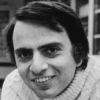Carl Sagan

Carl Sagan
Carl Edward Saganwas an American astronomer, cosmologist, astrophysicist, astrobiologist, author, science popularizer, and science communicator in astronomy and other natural sciences. He is best known for his contributions to the scientific research of extraterrestrial life, including experimental demonstration of the production of amino acids from basic chemicals by radiation. Sagan assembled the first physical messages sent into space: the Pioneer plaque and the Voyager Golden Record, universal messages that could potentially be understood by any extraterrestrial intelligence that might find...
NationalityAmerican
ProfessionScientist
Date of Birth9 November 1934
CityBrooklyn, NY
CountryUnited States of America
If there is life, then I believe we should do nothing to disturb that life. Mars then, belongs to the Martians, even if they are microbes.
Quickly capping 363 oil well fires in a war zone is impossible. The fires would burn out of control until they put themselves out... The resulting soot might well stretch over all of South Asia... It could be carried around the world... [and] the consequences could be dire. Beneath such a pall sunlight would be dimmed, temperatures lowered and droughts more frequent. Spring and summer frosts may be expected... This endangerment of the food supplies... appears to be likely enough that it should affect the war plans...
All inquires carry with them some element of risk. There is no guarantee that the universe will conform to our predispositions.
The gears of poverty, ignorance, hopelessness and low self-esteem interact to create a kind of perpetual failure machine that grinds down dreams from generation to generation. We all bear the cost of keeping it running. Illiteracy is its linchpin.
We live at a moment when our relationships to each other, and to all other beings with whom we share this planet, are up for grabs.
Philosophers and scientists confidently offer up traits said to be uniquely human, and the monkeys and apes casually knock them down -- toppling the pretension that humans constitute some sort of biological aristocracy among the beings on Earth.
A multitude of aspects of the natural world that were considered miraculous only a few generations ago are now thoroughly understood in terms of physics and chemistry.
Absolute certainty will always elude us. We will always be mired in error. The most each generation can hope for is to reduce the error. . . .
The universe forces those who live in it to understand it.
Books tap the wisdom of our species -- the greatest minds, the best teachers -- from all over the world and from all our history. And they're patient.
My long-time view about Christianity is that it represents an amalgam of two seemingly immiscible parts-the religion of Jesus and the religion of Paul. Thomas Jefferson attempted to excise the Pauline parts of the New Testament. There wasn't much left when he was done, but it was an inspiring document.
Has there ever been a religion with the prophetic accuracy and reliability of science? . . . No other human institution comes close.
A single message from space will show that it is possible to live through technological adolescence. . . . It is possible that the future of human civilization depends on the receipt of interstellar messages.
Some racists still reject the plain testimony written in the DNA that all the races are not only human but nearly indistinguishable. . . .